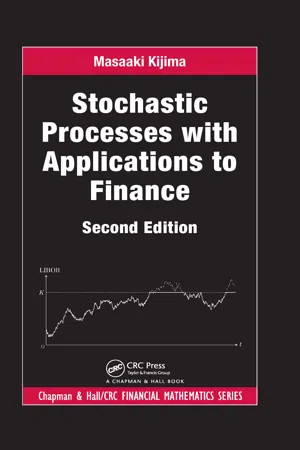
This is a test
- 343 pages
- English
- ePUB (mobile friendly)
- Available on iOS & Android
eBook - ePub
Stochastic Processes with Applications to Finance
Book details
Book preview
Table of contents
Citations
About This Book
Financial engineering has been proven to be a useful tool for risk management, but using the theory in practice requires a thorough understanding of the risks and ethical standards involved. Stochastic Processes with Applications to Finance, Second Edition presents the mathematical theory of financial engineering using only basic mathematical tools
Frequently asked questions
At the moment all of our mobile-responsive ePub books are available to download via the app. Most of our PDFs are also available to download and we're working on making the final remaining ones downloadable now. Learn more here.
Both plans give you full access to the library and all of Perlego’s features. The only differences are the price and subscription period: With the annual plan you’ll save around 30% compared to 12 months on the monthly plan.
We are an online textbook subscription service, where you can get access to an entire online library for less than the price of a single book per month. With over 1 million books across 1000+ topics, we’ve got you covered! Learn more here.
Look out for the read-aloud symbol on your next book to see if you can listen to it. The read-aloud tool reads text aloud for you, highlighting the text as it is being read. You can pause it, speed it up and slow it down. Learn more here.
Yes, you can access Stochastic Processes with Applications to Finance by Masaaki Kijima in PDF and/or ePUB format, as well as other popular books in Business & Finance. We have over one million books available in our catalogue for you to explore.
CHAPTER 1
Elementary Calculus: Toward Ito’s Formula
Undoubtedly, one of the most useful formulas in financial engineering is Ito’s formula. A goal of this chapter is to derive Ito’s formula from Taylor’s expansion. The derivation is not mathematically rigorous, but the idea is helpful in many practical situations of financial engineering. Important results from elementary calculus are also presented for the reader’s convenience. See, for example, Bartle (1976) for more details.
1.1 Exponential and Logarithmic Functions
Exponential and logarithmic functions naturally arise in the theory of finance when we consider a continuous-time model. This section summarizes important properties of these functions.
Consider the limit of sequence {an} defined by
Note that the sequence {an} is strictly increasing in n (Exercise 1.1). Associated with the sequence {an} is the sequence {bn} defined by
It can be readily shown that the sequence {bn} is strictly decreasing in n (Exercise 1.1) and an < bn for all n. Since
we conclude that the two sequences {an} and {bn} converge to the same limit. The limit is usually called the base of natural logarithm and denoted by e (the reason for this will become apparent later). That is,
The value is an irrational number (e = 2.718281828459 · · ·), ...
Table of contents
- Cover
- Half Title
- Series Page
- Title Page
- Copyright Page
- Contents
- Preface to the Second Edition
- Preface to the First Edition
- 1 Elementary Calculus: Toward Ito’s Formula
- 2 Elements in Probability
- 3 Useful Distributions in Finance
- 4 Derivative Securities
- 5 Change of Measures and the Pricing of Insurance Products
- 6 A Discrete-Time Model for the Securities Market
- 7 Random Walks
- 8 The Binomial Model
- 9 A Discrete-Time Model for Defaultable Securities
- 10 Markov Chains
- 11 Monte Carlo Simulation
- 12 From Discrete to Continuous: Toward the Black–Scholes
- 13 Basic Stochastic Processes in Continuous Time
- 14 A Continuous-Time Model for the Securities Market
- 15 Term-Structure Models and Interest-Rate Derivatives
- 16 A Continuous-Time Model for Defaultable Securities
- References
- Index